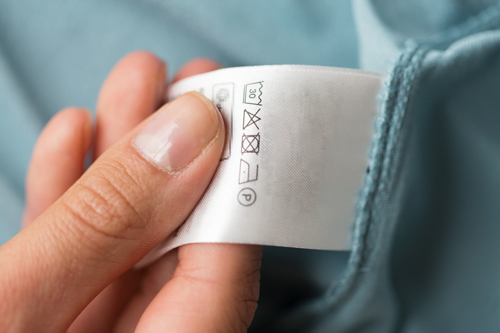
How to Wash and Care For Polyester Clothing
By ShirtSpace | Aug 23, 2019 | Updated Feb 07, 2024Polyester is a highly breathable, moisture-wicking fabric commonly used in apparel, linens, and upholstery. It resists wrinkles, fading, and shrinking when taken care of properly, proving to be an old favorite when it comes to t-shirt materials.
There's a reason why fabric lovers recommend 100% polyester (or a 50/50 blend) when it comes to comfortable shirts. Its shrink resistance and ability to maintain shape even through everyday wear and tear make it the perfect addition to any wardrobe.
But if you’re unsure how to wash polyester, then we want to help put you at ease. Read on to learn about caring for this fantastically durable material.
The Origin of Polyester
Polyester is a synthetic fiber derived from coal, air, water, and petroleum. Developed in a 20th-century lab from a chemical reaction between an acid and alcohol, this reaction formed fibers with long molecules that were stable and strong—bringing upon the famous polyester fabric.

However polyester wasn’t utilized in shirts and clothing overnight. It took a full decade from its discovery for this fabric to even hit the shelves!
In 1941, two British chemists named John Rex Whinfield and James Tennant Dickson patented “polyethylene terephthalate”—also known as PET or PETE—essentially creating Terylene, the first polyester fabric.
Five years later (in 1946), the chemical company DuPont bought out all polyester rights and developed the chemists’ version into something called Dacron. Finally, in 1951, the American public was introduced to polyester fabric.
But even then, the world wasn’t interested in polyester. People wanted to stick with natural materials like cotton or linen, so it took another 30 years for polyester to really take off. Eventually, after a lot of marketing (and the 1970’s), Americans finally accepted polyester as an everyday fabric in the 1980s—and the rest is history!
How to Wash 100% Polyester
While you should always adhere to the care tag’s instructions, most 100% polyester fabrics will require the same type of care when it comes to washing and drying. Follow these steps as a general guideline to washing your favorite polyester t-shirts.
Step #1: Turn the fabric inside out.
Although polyester is most famous for its anti-wrinkle capabilities, it does have some downfalls, such as the tendency to pill. Turning the shirt inside out will help prevent the outside of the shirt from facing any of the harsh movements inside the machine. In doing so, you can avoid unwanted pilling and potential shrinking.

Step #2: Use cold or warm water for your wash cycle.
Washing with cold water is always a safe bet when it comes to cleaning your clothing, especially if it’s with a material you’re unfamiliar with.
But 100% polyester will also do very well with warm water, which can help remove stains, prevent shrinkage, and avoid color bleeding into other clothing in the cycle.
Step #3: Use standard detergent.
Simple detergent (without the extra bells and whistles like “tough on stains” or “wrinkle release”) is the best route to go when dealing with most materials. While these formulas are helpful for several reasons, they can sometimes be too harsh on polyester t-shirts, which pill and bleed easily during vigorous cycles.
Step #4: Dry on low heat or air dry.
A low-temperature dry cycle is the best way to avoid shrinkage—even for 100% polyester. Although an otherwise durable material, polyester tends to shrink or even melt on extremely high temperatures. It’s best to play it safe and dry on low heat or just air dry your fabrics altogether, which will avoid any potential damage.
Does Polyester Shrink?
Polyester is one of the most popular fabrics when it comes to apparel because of its durability. Thanks to its synthetic chemical makeup, polyester is known to fight off unwanted wrinkles, which means that it’s improbable that a 100% polyester t-shirt will shrink in the wash or dryer.
However, it’s not uncommon to find t-shirts that have a combination of polyester materials. You might find a fabric that says 50% polyester and 50% cotton. In instances where the content isn’t 100% polyester, there is a probable chance of shrinkage, especially if it’s a t-shirt combined with shrink-prone fabrics like cotton.
How to Care for Polyester
Whether you choose to machine-wash or air-dry your polyester fabrics, most of us want to get the most out of our clothing. The most important thing is to consider the care label, which is usually found near the collar or along the lining of the torso.

The care label will tell you exactly what’s required to take proper care including information on the ideal:
-
Wash temperature
-
Type of washes
-
Bleaching options
-
Drying options
-
Ironing temperatures
-
Dry cleaning options
Unless otherwise specified, most polyester tags will tell you to machine wash in cold or warm water and tumble dry low.
Can You Iron Polyester?
The first thing you should do is check your care label. Some labels may say not to iron or dry clean, which is an essential bit of information you should adhere to. But if the label gives you the green light to iron your favorite t-shirt, then you can prepare your board.

Of course, you’ll want to be sure that you use the right heat settings. If your care label doesn’t specify the type of heat you can use, then it’s best to stick to a low setting on your iron, like 3. Iron setting 3 is relatively low compared to what heavyweight cotton requires, which is setting 7. Setting 3 should roughly translate to 300° Fahrenheit (or 148° Celcius). You don’t have to take any precautionary steps when ironing a polyester t-shirt—but you can flip it inside out to avoid any accidental tugging or pilling as you go over the fabric.
Finding the Best Polyester Clothing
Polyester is an excellent and versatile fabric that can be found in athletic wear, sleepwear, and even undergarments like socks and underwear. While you should always abide by the polyester’s care label, this hardy fabric is anything but finicky and can handle plenty of wear and tear.
If you’re searching for high-quality polyester clothing in a variety of styles, then you don’t have to look any further: ShirtSpace has thousands of 100% and blended polyester clothing, ranging from t-shirts to sweatshirts to athletic apparel. Browse through some of the nation’s most quality polyester clothing today!


Comments
marie sengupta07/21/2024 05:20 pm
hello, my name is Marie. how can I clean a bed skirt ruffle? the section that lies on the mattress is cotton. the skirt ruffle says 70% polyester. instructs to dry clean only and do not wash. I have a matching polyester cover which is same as the bed skirt and states to dry clean only and do not wash. question # 2) is there a method I can steam? like using an iron etc. thank you for your kind response in advance
Reply
ShirtSpace07/24/2024 04:23 pm
Hi, Marie. Because the bed skirt says to dry clean only, we highly recommend following the instructions provided by the manufacturer to avoid any unwanted damage to the material. Usually dry clean only fabrics are very sensitive to typical washing and drying practices that use water (or steam), as they use a liquid solvent instead. Thanks for reading our blog!
Reply
Michelle02/22/2024 06:05 pm
I have an office jacket made of 100% thick polyester material but unsmooth seam. I am not used to it, as most clothes have some spandex these days. Without ironing this jacket, how can I make it look flatter and more polished for the office environment? Thanks.
Reply
ShirtSpace02/23/2024 03:54 pm
Hi, Michelle. We have a few suggestions for you. 1. Steaming - use a handheld clothing steamer and run it along the rough edges and seams of the jacket to soften it up. 2. Wet the seams with a damp cloth and then place the jacket in the dryer on a low heat setting for a couple of minutes to relax the fabric (only do this method if the label says you can machine dry the jacket). 3. Wet the seams with a damp cloth and then use a hair dryer on a low heat setting to soften the seams. 4. Lay the jacket out flat and then use a heavy/flat-bottomed object to press the seam down. Let it sit for 24 hours before removing the object. 5. Gently massage fabric softener onto the seams. You can let this sit on the seams for a short period. Then gently wash the garment and hang dry. 6. If these methods do not work, consider taking the jacket to a professional cleaner or tailor to see if they can do anything to help.
Reply
Virginia Rowlan01/18/2024 09:54 pm
How do you get soap scum off of the shirt that's 100% polyester
Reply
ShirtSpace01/24/2024 12:06 am
Hi, Virgina. That is a great question! Causes of soap residue can include: undissolved or too much detergent, overloading your wash machine, over using fabric softener, hard water, or a dirty wash machine. We recommend trying to pinpoint why this is happening to best prevent it from happening again. To remove this build up, wash your item in the hottest water suitable for the fabric at hand. Be sure to avoid washing with fabric softener or detergent, but add one cup of distilled vinegar to the water. Oxygen-based bleach can also help stubborn soap stains. We recommend checking out his excellent article for more details: https://www.thespruce.com/causes-white-residue-washed-clothes-2146672
Reply
Elma saul06/19/2023 01:59 pm
How do I get stains out of white polyester shirts.
Reply
ShirtSpace06/19/2023 05:04 pm
Hi, Elma! That's a great question. First, be sure to act promptly: Treat the stain as soon as possible. The longer a stain sits on the fabric, the harder it becomes to remove. Then blot, don't rub. Gently blot the stain with a clean white cloth or paper towel to remove any excess liquid or residue. Avoid rubbing the stain, as it can push it deeper into the fabric. Then check the care label. Before proceeding with any stain removal method, check the care label on the garment to ensure that it's safe to use specific treatments or chemicals on the fabric. Then Pre-treat the stain. Depending on the type of stain, you can try different pre-treatment methods. Here are a few common options: Liquid detergent - Apply a small amount of liquid detergent directly to the stain, gently rubbing it in with your fingers or a soft brush. Let it sit for 10-15 minutes before laundering. Or try stain remover - Use a commercial stain remover that's safe for polyester fabrics. Follow the instructions on the product for application and waiting time. You can also try a vinegar solution- Mix equal parts of white vinegar and water. Dab the stain with the solution, let it sit for a few minutes, and then rinse it thoroughly before laundering. Finally, launder properly. Once you've pre-treated the stain, wash the garment according to the care instructions. Use a gentle cycle with cold water, as hot water can set the stain. Avoid using bleach unless the care label explicitly allows it. After laundering, check for stain removal. Inspect the garment to see if the stain has been completely removed. If it's still visible, avoid drying the garment, as heat can set the stain further. Repeat the pre-treatment process, or consider seeking professional help for stubborn stains. If the stain is completely removed, consider air-drying the garment in direct sunlight. Sunlight can naturally bleach and brighten white fabrics. We hope this helped! Thanks so much for reading our blog!
Reply
JOYCE MCEACHIN 01/25/2023 09:28 pm
Hi, but why isn't there a label in the jackets that I just purcashed with the fleece lining? Do I wash it the same way as I would polyester?
Reply
ShirtSpace01/26/2023 09:33 pm
Hi, Joyce. We are sorry the inner lining is not labeled properly. We are curious to know which brand and style you purchased. To help you properly care for the inside fleece lining of your jacket, please consult this blog we wrote: https://www.shirtspace.com/blog/how-to-wash-fleece Thank you for shopping with us and reading our blog!
Reply
ShirtSpace10/12/2022 06:18 pm
Hi Eileen! It is recommended you don't put 100% polyester in the dryer, and if you must it is recommended not to use high temperatures. Thank you for reading!
Reply
Oliver06/04/2021 10:30 pm
very helpful thank you
Reply
ShirtSpace10/12/2022 06:14 pm
Hi Oliver! We are so happy to hear you found our blog helpful. Thank you for taking the time to read!
Reply
Hilary M Conley03/07/2021 03:27 pm
Follow the instructions...take it to the dry cleaners.
Reply
ShirtSpace10/12/2022 06:19 pm
Hi Hilary! Thank you for reading!
Reply
Eileen burton01/03/2021 09:54 pm
I have an expensive jump suit and is 100% polyester the label says dry clean only what do I do?
Reply
Leave a Comment
We take your privacy seriously and will not share or publish your email address.
This site is protected by reCAPTCHA and the Google Privacy Policy and Terms of Service apply.